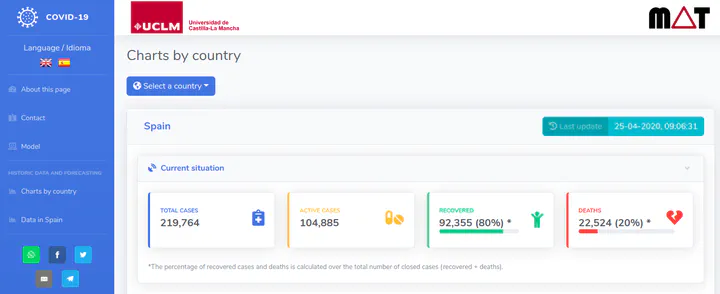A webpage to monitor the propagation of COVID-19 disease

The Models and Algorithms for Transport Systems (MAT) group from the University of Castilla-La Mancha (UCLM), to which I belong, has developed a web page for the monitoring, and visualization of the COVID-19 disease. This site, through the use of mathematical techniques, as well as data analysis and artificial intelligence, analyzes the evolution and expansion of the coronavirus with the aim of providing information to monitor the progress of the pandemic. These analytical techniques, according to the group led by UCLM Mathematics Department professor Ricardo Garcia Ródenas, “allow to support decision making processes”.
The website is accesible at: https://covid19.esi.uclm.es/.
For each country, it is possible to view the total number of cases, the active cases, deaths and recoveries. The data for each country is updated daily and has been obtained from a public repository. In addition, for each of the countries, a one-week view forecast of the number of new cases, recoveries and deaths is provided.
Similarly, the website shows the evolution of the virus at the level of the Autonomous Communities in Spain. The data of each one of the communities is daily obtained from the database provided by the Instituto de Salud Carlos III de Madrid, whose data is used by the Spanish Health Ministry. Thus, for each of the Autonomous Communities, the number of total cases, active cases, deaths and recoveries is reported, as well as the number of patients hospitalised or critical (in the ICU). In addition, it is possible to view a one-week view forecast of the number of new cases, recoveries and deaths for each autonomous community.
Finally, the website shows the evolution of the COVID-19 infection rate over time for each country and for all the autonomous communities of Spain, together with a prediction at one week’s time. I is also possible to compare the rate with an equilibrium point that allows to clarify if a country or a certain autonomous community is in an expansion or contraction phase of the epidemic. The aim is to monitor the state of the epidemic and provide information and knowledge to authorities who are working hard on a daily basis to reduce its effects.